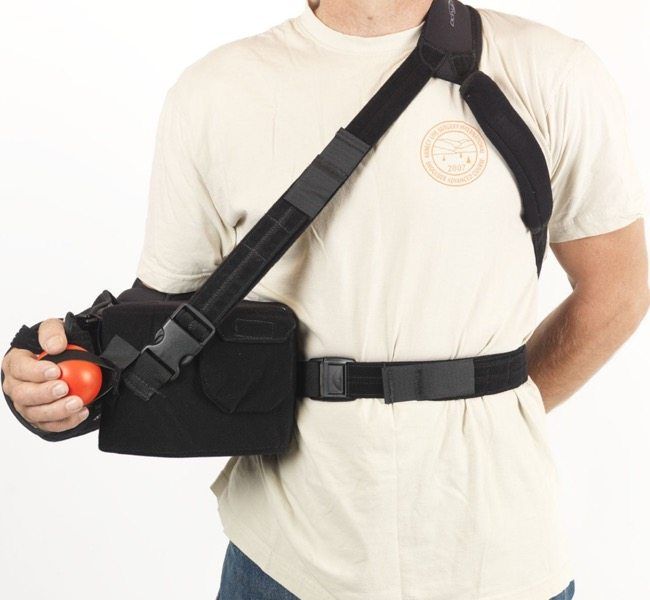Immobilization is commonly performed after acute first time shoulder dislocations. The goal of immobilization is to protect the shoulder and allow healing in an attempt to minimize recurrent instability down the road, which isn’t uncommon.
Unfortunately, once you dislocate your shoulder, you have a decent chance of it happening again.
Traditionally, immobilization has occurred with the shoulder in a sling by the person’s side. This puts the shoulder in adduction and internal rotation. Considering that most anterior dislocations occur with the arm in an abducted and externally rotated position, this seemed to make sense to take stress of the tissue.
However, a study was published in 2001 by Itoi in the Journal of Bone and Joint Surgery discussing a new position of immobilization in shoulder external rotation.
The authors used MRI to examine the capsule in both the position of shoulder internal rotation and external rotation. They showed that the anterior capsule tissue was better approximated in the externally rotated position. Other recent studies have agreed with these results.
This was an interesting finding and lead to a follow up study by the same group that was published in 2003 in the Journal of Shoulder and Elbow Surgery. In this study, the authors prospectively assessed the recurrent instability rate in people that were immobilized in either internal or external rotation.
The results showed that there was a 30% recurrent instability rate in those immobilized in the traditional internally rotated sling position, compared to 0% in those immobilized in external rotation.
Which Position is Best to Immobilize the Shoulder After a Dislocation?
Based on these two studies, many began immobilizing the shoulder after dislocation in this position of external rotation. There are now many shoulder immobilization braces on the market that position the shoulder in ER.
Since these two studies many have tried to replicate the original results of Itoi with mixed results.
I must admit that any time a novel technique, clinical test, or approach is introduced in the literature and the original author has a 100% success rate, I proceed a little cautiously until others have replicated their research.
Clinically, there appears to be no difference in recurrence rates when comparing immobilizing the shoulder in either internal or external rotation. This has been shown in several studies.
A recent meta-analysis was published in the American Journal of Sports Medicine that reviewed 6 randomized control trials and found no significant difference in recurrence rate. This was consistent with a prior systematic review of the Cochran Database, which agreed.
Basic Science Vs. Clinical Studies
This is an interesting situation, where basic science studies appear to show that immobilization in external rotation may be theoretically more beneficial after shoulder dislocations, but clinical studies have not shown any benefit or reduced occurrence of recurrent instability. It appears anatomically that immobilizing in a position of external rotation would put the labral tissue in the best position to heal.
I personally see this as a challenging study as many people are simply not compliant with immobilization after dislocations, especially once the acute trauma tends to settle down. One particular study reported a compliance rate between 53-72%.
That’s not great.
As of now, it seems like we need more research to make a more definitive decision. However, keep in mind that these studies have not shown immobilization in internal rotation to be MORE beneficial, they just showed no difference between the two. So as of now, if I dislocated my shoulder tomorrow, I would probably immobilize myself in external rotation based on the anatomical studies that show better tissue approximation.
For those out there, what are you seeing clinically in your area? I would imagine this varies a lot based on your location and physicians you work with each day. Are docs still immobilizing people in external rotation? Have you found outcomes to differ from those immobilized in internal rotation? Comment below and let me know.
 How Treatment Differs Between Atraumatic and Traumatic Shoulder Instability
How Treatment Differs Between Atraumatic and Traumatic Shoulder Instability
If you are interested in learning more on this topic, I have an Inner Circle presentation on How Treatment Differs Between Atraumatic and Traumatic Shoulder Instability. We discuss this topic, plus a lot more, in much greater detail.




 How Treatment Differs Between Atraumatic and Traumatic Shoulder Instability
How Treatment Differs Between Atraumatic and Traumatic Shoulder Instability


